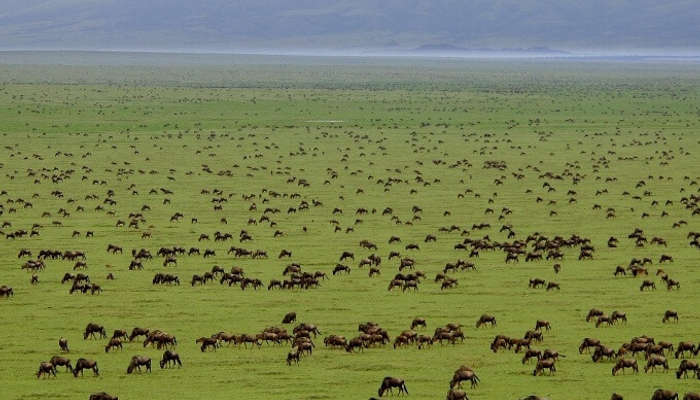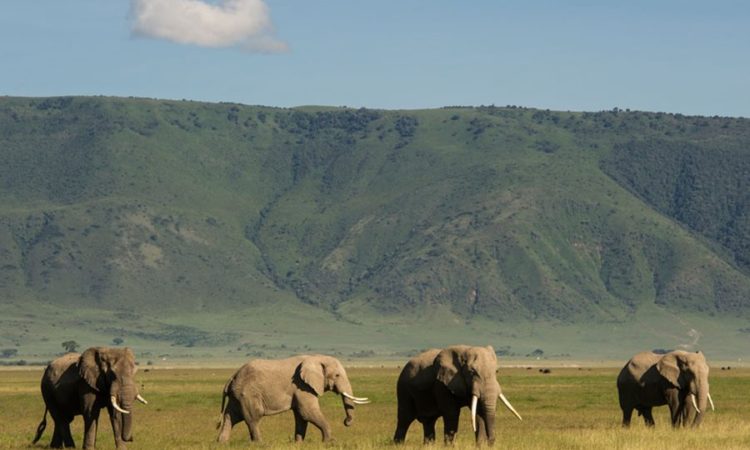6 days Tanzania Serengeti Migration Safari tour overview:
Below are the description about 6 Days Serengeti Migration Safari Tour in Tanzania with well planned itinerary.

About 6 Days Serengeti Migration Safari Tour in Tanzania
This 6-DayGreat Serengeti Migration (EAST OF THE GRUMETI RIVER & NAABI HILL) Wet season Safari package has been designed specifically to focus on and to increase your chance to see the great Serengeti Wildebeest Migration in Eastern Serengeti. The eastern plains of the Serengeti ecosystem encompass a massive area. They begin roughly just east of Naabi Hill. They extend east through the Gol Kopjes, Lemuta Hill, Nasera Rock, AngataKiti, the Salei Plains, and to the Ngorongoro Highlands. Wildebeest usually linger in north-eastern Serengeti and migrate further south in December. You will enjoy a Serengeti East Safari during November and December when the mega herds return from Masai Mara National Reserve to the rich plains of the Serengeti National Park, east of the Grumeti River, passing through Lobo and Western Loliondo and under the majestic Gol mountains, at the northern edge of the Ngorongoro Conservation Area. Here, you will find one of the utmost concentrations of cheetahs in the Serengeti, preying on half a million indigenous gazelles and impalas including migrants. The mountains shelter colonies of Ruppell's Griffon Vultures. Wildebeest cover the central-east valleys on their way north after the long rains, and some pour through the scenic bottleneck of the AngataKiti pastures during the shorter rains on their way back south. But with or without the migratory millions, this area is breathtaking for its immensity and feeling of freedom the world-famous Ngorongoro Crater. Lobo, at the eastern edge of the Serengeti National Park and on a small stretch of the Grumeti River that offers excellent year-round game observation, gives unrivaled views of grassland and kopjes. Further south, outside the game park border, and almost a third as large as the Serengeti National Park, Loliondo is a private concession and more versatile.
-
Day 1
Kilimanjaro Airport to Arusha
Upon arrival at Arusha/Kilimanjaro airport, your Tanzania Widerange African Safaris guide will pick you up and transport you to your hotel in Arusha or Moshi Tanzania. Set up your lodging, relax, and get acclimated to the African environment. The next day, you'll be ready to begin your 5-day Great Tanzania Eastern Serengeti Migration safari (east of the Grumeti River & NAABI HILL). Arusha is a city in northern Tanzania and the headquarters of the Arusha Region, with a population of 416,442 plus 323,198 in the surrounding Arusha District Arusha, located below Mount Meru on the eastern border of the Great Rift Valley’s eastern branch, has a temperate climate. The Serengeti National Park, the Ngorongoro Conservation Area, Lake Manyara National Park, Olduvai Gorge, Tarangire National Park, Mount Kilimanjaro, and Arusha National Park on Mount Meru are all close to the city.
-
Day 2
Arusha to Manyara
On this day, you will depart Arusha, Tanzania's base town for safaris in northern Tanzania, for a magnificent journey down the Arusha-Dodoma highway to Lake Manyara National Park. You will drive and arrive in Lake Manyara in 2 hours, passing by a supermarket (if desired) for any last-minute shopping of any personal goods that you may require. Your driver will handle the paperwork at the park's entrance before taking you on your first game drive. This is a smaller park in Tanzania, yet it nevertheless provides a rewarding and diverse safari experience. Elephants, hippos, giraffes, buffaloes, antelopes, and some of Africa's largest baboon troupes abound at Lake Manyara National Park, an untouched wonderland of groundwater forest fed by underground springs. Manyara's lakeshore is teeming with birdlife, and while looking for birds, you might spot one of the elusive tree-climbing lions, which attract visitors from all over the world. There are also a surprising number of other large mammals, and the striking cliffs of the Rift escarpment provide a dramatic backdrop. We return to Manyara or Karatu for the night after the game drive.
-
Day 3
Lake Manyara to Central Serengeti
We depart early after breakfast from Manyara (Mtowambu) and travel across the Great Rift Valley's floor, up the escarpment, and through the Ngorongoro Conservation Area in what will ultimately be a pleasant and enjoyable scenic drive as you take in the beautiful scenery and breathtaking visitors on our way to the Serengeti National Park. Serengeti National Park is known for its boundless plains that stretch as far as the eye can see. We'll head to the Lobo neighborhood, which is slightly north of Seronera (central Serengeti National Park). Every year around July/August, the wildebeest migration passes through the Lobo area en route to Kenya's Masai Mara Game Reserve, and again in late October/November en route to the southern Serengeti National Park. Arrive at the Serengeti late in the afternoon for an evening game drive until evening, when you will settle into a camp/lodge, have dinner, and sleep. Lunch is served at one of the picnic areas, most likely near the Naabi Hill Gate, where you may stretch your legs while your guide completes the necessary registration and paperwork. Serengeti dinner and overnight All meals are provided.
-
Day 4
Central Serengeti to Eastern Serengeti (East of the Grumeti River and Naabi River)
After breakfast, we depart for the Serengeti National Park's eastern portions, also known as the EAST OF THE GRUMETI RIVER, where we will take a game drive en-route from Seronera to the Eastern Serengeti. We will arrive at the resort in time for lunch and then go on an afternoon game drive around the vicinity. Depending on rainfall patterns, the wildebeest migration can be found in the Eastern Serengeti area in November, December, and early January. They usually linger in the north-eastern Serengeti until December, when they migrate further south. Dinner and overnight in the eastern Serengeti area, as per the standard and type of accommodation option requested.
-
Day 5
Full Day Game Drive (Eastern Serengeti) Back to Central Serengeti
Enjoy a full day of game viewing in the Eastern Serengeti after breakfast. Wildebeest normally stay in the Serengeti's northern reaches until December, when they move south. During the wet season, the Gol Kopjes on the Eastern Plains have the highest number of cheetahs in Africa. The majority of Serengeti cheetahs are migratory, following the Thomson's Gazelle migration to the eastern short grass plains during the rainy season and then returning to the Central Serengeti (plains/woodland border) during the dry season. The eastern grasslands of the Serengeti and throughout Africa offer the best cheetah views during the rainy season. Several groups of cheetahs are likely to be encountered during a full-day game drive to the GOL kopjes. Cheetahs are primarily diurnal (daytime) hunters, and if you're lucky, you'll get to see the world's fastest land mammal in action. During the green season, the eastern plains are home to the highest densities of hyenas, in addition to cheetahs. Hyena clans of up to 30 members have been sighted routinely from Naabi Hill east through the Gol Kopjes and Lemuta Hill. Hyenas, the most abundant predator in the ecosystem, are semi-nomadic and 'commute' to the Eastern Plains from their den sites in the Central Serengeti during the rainy season. During the wet season, lion numbers are also high on the eastern plains. The majority of lions in the Serengeti are resident, although a considerable minority (about 20%) are nomadic, and they do accompany migratory animals to the plains during the rainy season. Lions, on the other hand, are infrequently observed east of Lemuta and are much more common inside the Serengeti proper, notably the Gol Kopjes area. After lunch, you will continue with your Serengeti wildlife viewing before traveling to Central Serengeti for the night. Serengeti Camp or Lodge for dinner and sleep. All meals are provided.
-
Day 6
Central Serengeti to Ngorongoro
Proceed to the Serengeti for morning and afternoon game drives, with a mid-afternoon lunch and leisure break at the lodge. In the Masai language, Serengeti means "endless plains." Carnivores such as the leopard, lion, hyena, and cheetah can be found in the central plains. The yearly migration of wildebeest and zebra between the Kenyan Mara and the Serengeti usually takes place in this park. Eagles, ducks, geese, egrets, vultures, secretary birds, ibis, storks, herons, kites, pelicans, cranes, and guinea fowl are among the many bird species spotted here. The Serengeti National Park is possibly the best-renowned wildlife sanctuary in the world with over 3 million large mammals. The "big 5" - elephants, Rhino, Lion, Leopard, and Buffalo - are among the 35 species of plains animals that can be observed there. Hippo, giraffe, eland, impala, and other antelope species, as well as baboons, monkeys, and over 500 bird species, can all be found here. Huge herds of wildebeest, gazelle, and zebra begin their annual spectacular migration northwards in May or early June. Predators such as lions, cheetahs, and wild dogs trail them, with vultures circling overhead! After lunch, you will continue with game viewing in Serengeti, making your way to the Serengeti National Park gate to check out, and then continue with game viewing on the way to Ngorongoro Crater. Dinner and an overnight stay at a Ngorongoro Crater rim camp or lodge.
-
Day 7
Ngorongoro Crater Back to Arusha
After breakfast, descend into the crater with a lunch box and enjoy a 7-hour game drive. A volcano the size of Mount Kilimanjaro emerged from the northern Tanzanian highlands millions of years ago. The Ngorongoro Crater, the world's biggest unflooded caldera, was produced by its eruption. The crater is now inactive and teeming with wildlife, making it a great place to go on game drives in search of the Big Five. The natural protection provided by the crater's 600 m (1,968 ft) high walls allows many species to survive. It is one of the world's most densely populated African wildlife habitats, home to an estimated 30,000 animals, and the best spot in Tanzania to witness critically endangered black rhino. The crater hosts a diverse range of animals, including herds of wildebeest, zebra, buffalo, eland, warthog, hippo, and enormous African elephants, and the park is supported by year-round water and fodder. Another major attraction of this beautiful national park is its large predator population, which includes lions, hyenas, jackals, cheetahs, and the elusive leopard crater floor. You will go on a game drive after a picnic lunch, and then we will drive to Arusha/Moshi for the night.






INCLUSIONS